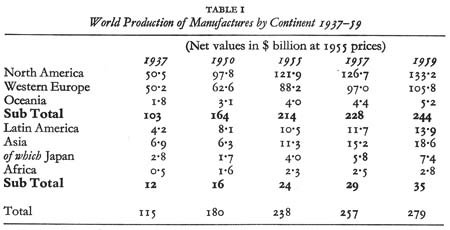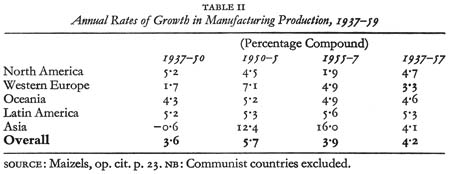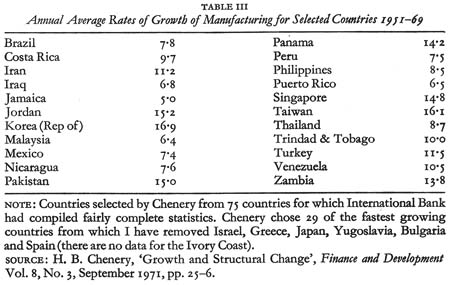Current Marxist views of the relationship of imperialism to the non-socialist underdeveloped countries are that the prospects of independent economic development or independent industrialization in such countries are nil or negligible (unless they take a socialist option); and that the characteristics of backwardness, underdevelopment and dependencefootnote1 which prevent such development are the necessary results of imperialist domination. Despite the state of controversy in which the theory of imperialism currently finds itself, these conclusions were generally accepted by all participants in a recent symposium on imperialism.footnote2 It will, on the contrary, be the burden of this article that empirical observations suggest that the prospects for successful capitalist economic development (implying industrialization) of a significant number of major underdeveloped countries are quite good; that substantial progress in capitalist industrialization has already been achieved; that the period since the Second World War has been marked by a major upsurge in capitalist social relations and productive forces (especially industrialization) in the Third World; that in so far
To avoid misunderstanding, we must state at the outset that none of this is meant to imply that imperialism has ceased to exist. It does exist as a system of inequality, domination and exploitation. What we wish to indicate are elements of change. It is a striking, if not unprecedented, irony that socialist scholars should be giving maximum attention to the phenomenon of dependence at the very time when the phenomenon itself is suffering irreversible decline. The political importance of these issues is immeasurable. In a world changing rapidly in a highly complex fashion, there is a possibility that Marxist analysis (on which Marxism’s power to change society ultimately depends) will lag seriously behind reality, that new elements in the situation will not be remarked and that the resulting distortion will decisively weaken revolutionary strategy.
Specifically, the danger is that the international relationships of class forces will be misunderstood. A crucial element in these relationships must be the success or otherwise of Third World capitalist development. Successful capitalist development is here understood as that development which provides the appropriate economic, social and political conditions for the continuing reproduction of capital, as a social system representing the highest form of commodity production. It is aspects of this development we examine below. The problem as posed in these terms differs from that posed by many authorities who analyse instead the adequacy of ‘development’ (sometimes capitalist development) as a process satisfying the needs of the masses (or ‘the problems of the nation’). Nor will this article discuss the most immediate problem which underdeveloped countries face today: the backwardness of their agriculture and its consequence: the unevenness and imbalance of their economies. All that will be attempted here will be to
Despite statements and predictions to the contrary, the underdeveloped world, considered as a whole, has made considerable progress in industrialization in the post-war period. Already, by the 1950s, the Third World accounted for a higher proportion of the world’s manufacturing output than it did pre-war. Whereas in 1937 the developed capitalist countries accounted for about nine times the manufacturing output of Latin America, Africa and Asia, by 1959 the ratio had been reduced to seven to one.footnote4 Moreover, this tendency for manufacturing output to grow faster in the underdeveloped world than in the developed capitalist world continued into the 1960s—with Third World manufacturing output growing at about 7 per cent per annum between 1960 and 1968 while that in the advanced capitalist world grew at about 6 per cent.footnote5 This was despite the fact that during the 1960s industrial growth in the developed capitalist world has been exceptionally high by historical standards, overall gnp growth easily exceeding the famous oecd Growth Target for the 1960s of 50 per cent over the decade (see tables i and ii).
It may be argued that this apparent success is attributable to the high statistical growth rates associated with very small industrial bases and is therefore delusive, or, alternatively, that in terms of output per head the record of the underdeveloped countries compared with the developed capitalist countries is rather poor. However, inspection of the figures for individual countries over a longish period shows the ability of many underdeveloped countries to maintain faster rates of growth of manufacturing output than the already industrialized economies (table iii).footnote6 Moreover, the really unique feature of the post-war industrialization advance in the Third World taken as a whole, is its sustained momentum over a period longer than any previously recorded.footnote7 Thirdly, this industrialization has been (and is) taking place in a period when neither war nor world depression have acted to ‘cut off’ the ThirdWorld from the advanced capitalist countries—and yet it is this cutting-
Certainly, the growth of manufacturing output per head in the underdeveloped countries does lag behind that of the imperialist world, in part because of the unprecedented post-war rates of population growth in the former. But to take the growth of manufacturing output per head as a basis of comparison is to apply an extremely demanding criterion of performance. Similarly, the same point applies to the growth of total output per head. Clearly, from the point of view of living standards, per capita growth rates are the most relevant criterion. However, from the perspectives of the distribution of world industrial power and the growth of the market (which are more relevant to the problem at hand) total, rather than per capita, growth rates are the central issue.
If the advance of modern manufacturing is considered crucial to the elimination of underdevelopment, then the proportion of gross domestic product accounted for by manufacturing in the underdeveloped countries is a useful, if very approximate, comparative indicator.footnote9 The figures are rather impressive. For the underdeveloped countries as a whole the proportion of gross domestic product accounted for by manufacturing rose from 14·5 per cent in 1950–4 to 17.9 per cent in 1960–4, while in the developed capitalist countries during 1960–4 manufacturing contributed 31·3 per cent to gdp footnote10. The proportion in underdeveloped countries is already over half that of developed ones.


